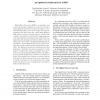Free Online Productivity Tools
i2Speak
i2Symbol
i2OCR
iTex2Img
iWeb2Print
iWeb2Shot
i2Type
iPdf2Split
iPdf2Merge
i2Bopomofo
i2Arabic
i2Style
i2Image
i2PDF
iLatex2Rtf
Sci2ools
IPPS
2006
IEEE
2006
IEEE
An optimal architecture for a DDC
Digital Down Conversion (DDC) is an algorithm, used to lower the amount of samples per second by selecting a limited frequency band out of a stream of samples. A possible DDC algorithm consists of two simple Cascading Integrating Comb (CIC) filters and a Finite Input Response (FIR) filter preceded by a modulator that is controlled with a Numeric Controlled Oscillator (NCO). Implementations of the algorithm have been made for five architectures, two Application Specific Integrated Circuits (ASIC), a General Purpose Processor (GPP), a Field Programmable Gate Array (FPGA), and the Montium Tile Processor (TP). All architectures are functionally capable of performing the algorithm. The differences between the architectures are their performance, flexibility and energy consumption. In this paper we compared the energy consumption of the architectures when performing the DDC algorithm. The ASIC is the best solution if digital down conversion is constantly required. When digital down con...
Architectures | DDC Algorithm | Distributed And Parallel Computing | IPPS 2006 | Possible Ddc Algorithm |
Related Content
| Added | 12 Jun 2010 |
| Updated | 12 Jun 2010 |
| Type | Conference |
| Year | 2006 |
| Where | IPPS |
| Authors | Tjerk Bijlsma, Pascal T. Wolkotte, Gerard J. M. Smit |
Comments (0)

